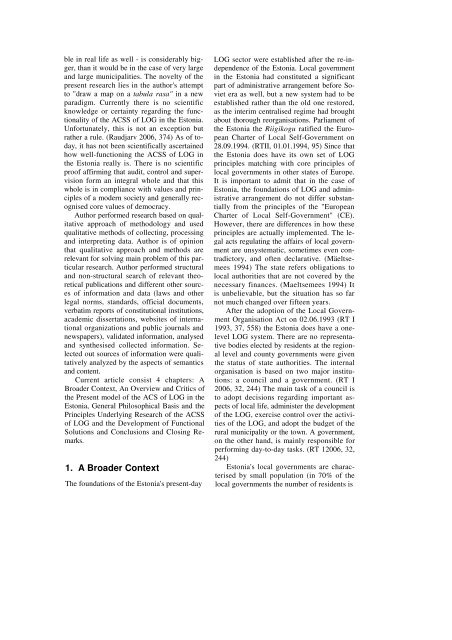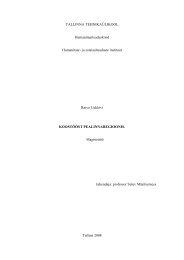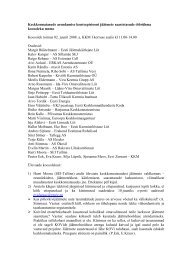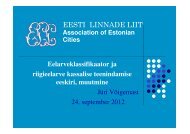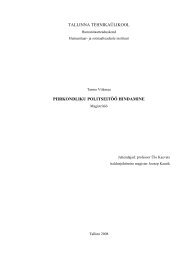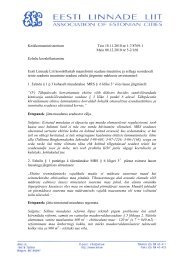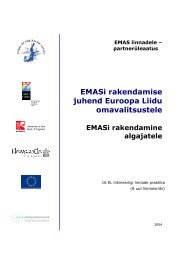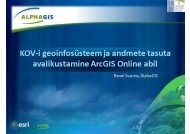Theoretical and Practical Problems Related to the Audit, Control and ...
Theoretical and Practical Problems Related to the Audit, Control and ...
Theoretical and Practical Problems Related to the Audit, Control and ...
You also want an ePaper? Increase the reach of your titles
YUMPU automatically turns print PDFs into web optimized ePapers that Google loves.
le in real life as well - is considerably bigger,<br />
than it would be in <strong>the</strong> case of very large<br />
<strong>and</strong> large municipalities. The novelty of <strong>the</strong><br />
present research lies in <strong>the</strong> author's attempt<br />
<strong>to</strong> "draw a map on a tabula rasa" in a new<br />
paradigm. Currently <strong>the</strong>re is no scientific<br />
knowledge or certainty regarding <strong>the</strong> functionality<br />
of <strong>the</strong> ACSS of LOG in <strong>the</strong> Es<strong>to</strong>nia.<br />
Unfortunately, this is not an exception but<br />
ra<strong>the</strong>r a rule. (Raudjarv 2006, 374) As of <strong>to</strong>day,<br />
it has not been scientifically ascertained<br />
how well-functioning <strong>the</strong> ACSS of LOG in<br />
<strong>the</strong> Es<strong>to</strong>nia really is. There is no scientific<br />
proof affirming that audit, control <strong>and</strong> supervision<br />
form an integral whole <strong>and</strong> that this<br />
whole is in compliance with values <strong>and</strong> principles<br />
of a modern society <strong>and</strong> generally recognised<br />
core values of democracy.<br />
Author performed research based on qualitative<br />
approach of methodology <strong>and</strong> used<br />
qualitative methods of collecting, processing<br />
<strong>and</strong> interpreting data. Author is of opinion<br />
that qualitative approach <strong>and</strong> methods are<br />
relevant for solving main problem of this particular<br />
research. Author performed structural<br />
<strong>and</strong> non-structural search of relevant <strong>the</strong>oretical<br />
publications <strong>and</strong> different o<strong>the</strong>r sources<br />
of information <strong>and</strong> data (laws <strong>and</strong> o<strong>the</strong>r<br />
legal norms, st<strong>and</strong>ards, official documents,<br />
verbatim reports of constitutional institutions,<br />
academic dissertations, websites of international<br />
organizations <strong>and</strong> public journals <strong>and</strong><br />
newspapers), validated information, analysed<br />
<strong>and</strong> syn<strong>the</strong>sised collected information. Selected<br />
out sources of information were qualitatively<br />
analyzed by <strong>the</strong> aspects of semantics<br />
<strong>and</strong> content.<br />
Current article consist 4 chapters: A<br />
Broader Context, An Overview <strong>and</strong> Critics of<br />
<strong>the</strong> Present model of <strong>the</strong> ACS of LOG in <strong>the</strong><br />
Es<strong>to</strong>nia, General Philosophical Basis <strong>and</strong> <strong>the</strong><br />
Principles Underlying Research of <strong>the</strong> ACSS<br />
of LOG <strong>and</strong> <strong>the</strong> Development of Functional<br />
Solutions <strong>and</strong> Conclusions <strong>and</strong> Closing Remarks.<br />
1. A Broader Context<br />
The foundations of <strong>the</strong> Es<strong>to</strong>nia's present-day<br />
LOG sec<strong>to</strong>r were established after <strong>the</strong> re-independence<br />
of <strong>the</strong> Es<strong>to</strong>nia. Local government<br />
in <strong>the</strong> Es<strong>to</strong>nia had constituted a significant<br />
part of administrative arrangement before Soviet<br />
era as well, but a new system had <strong>to</strong> be<br />
established ra<strong>the</strong>r than <strong>the</strong> old one res<strong>to</strong>red,<br />
as <strong>the</strong> interim centralised regime had brought<br />
about thorough reorganisations. Parliament of<br />
<strong>the</strong> Es<strong>to</strong>nia <strong>the</strong> Riigikogu ratified <strong>the</strong> European<br />
Charter of Local Self-Government on<br />
28.09.1994. (RTII, 01.01.1994, 95) Since that<br />
<strong>the</strong> Es<strong>to</strong>nia does have its own set of LOG<br />
principles matching with core principles of<br />
local governments in o<strong>the</strong>r states of Europe.<br />
It is important <strong>to</strong> admit that in <strong>the</strong> case of<br />
Es<strong>to</strong>nia, <strong>the</strong> foundations of LOG <strong>and</strong> administrative<br />
arrangement do not differ substantially<br />
from <strong>the</strong> principles of <strong>the</strong> "European<br />
Charter of Local Self-Government" (CE).<br />
However, <strong>the</strong>re are differences in how <strong>the</strong>se<br />
principles are actually implemented. The legal<br />
acts regulating <strong>the</strong> affairs of local government<br />
are unsystematic, sometimes even contradic<strong>to</strong>ry,<br />
<strong>and</strong> often declarative. (Mäeltsemees<br />
1994) The state refers obligations <strong>to</strong><br />
local authorities that are not covered by <strong>the</strong><br />
necessary finances. (Maeltsemees 1994) It<br />
is unbelievable, but <strong>the</strong> situation has so far<br />
not much changed over fifteen years.<br />
After <strong>the</strong> adoption of <strong>the</strong> Local Government<br />
Organisation Act on 02.06.1993 (RT I<br />
1993, 37, 558) <strong>the</strong> Es<strong>to</strong>nia does have a onelevel<br />
LOG system. There are no representative<br />
bodies elected by residents at <strong>the</strong> regional<br />
level <strong>and</strong> county governments were given<br />
<strong>the</strong> status of state authorities. The internal<br />
organisation is based on two major institutions:<br />
a council <strong>and</strong> a government. (RT I<br />
2006, 32, 244) The main task of a council is<br />
<strong>to</strong> adopt decisions regarding important aspects<br />
of local life, administer <strong>the</strong> development<br />
of <strong>the</strong> LOG, exercise control over <strong>the</strong> activities<br />
of <strong>the</strong> LOG, <strong>and</strong> adopt <strong>the</strong> budget of <strong>the</strong><br />
rural municipality or <strong>the</strong> <strong>to</strong>wn. A government,<br />
on <strong>the</strong> o<strong>the</strong>r h<strong>and</strong>, is mainly responsible for<br />
performing day-<strong>to</strong>-day tasks. (RT 12006, 32,<br />
244)<br />
Es<strong>to</strong>nia's local governments are characterised<br />
by small population (in 70% of <strong>the</strong><br />
local governments <strong>the</strong> number of residents is


